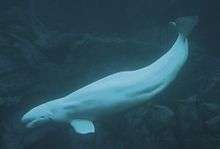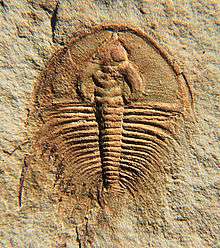Paleontology in Vermont

Paleontology in Vermont refers to paleontological research occurring within or conducted by people from the U.S. state of Vermont. Fossils are generally uncommon in Vermont. Nevertheless, however, significant finds have been made in the state.[1] Very few fossils are known in Vermont east of the Green Mountains due to the type of rock underlying that area.[1] During the early part of the Paleozoic era, Vermont was covered by a warm, shallow sea that would end up being home to creatures like brachiopods, corals, crinoids, ostracoderms, and trilobites. There are no rocks in the state from the Carboniferous, Permian, Triassic, or Jurassic periods. The few Cretaceous rocks present contain no fossils. The Paleogene and Neogene periods are also absent from the local rock record. During the Ice Age, glaciers scoured the state. At times the state was inundated by seawater, allowing marine mammals to venture in. After the seawater drained away the state was home to mastodons. Local fossils had already attracted scientific attention by the mid-19th century when mastodon remains were found in Rutland County. In 1950 a major Paleozoic invertebrate find occurred. The Pleistocene Beluga whale Delphinapterus leucas is the Vermont state fossil.
Prehistory
No Precambrian fossils are known from Vermont. As such, the state's fossil record does not begin until the Paleozoic. During the Cambrian period the state was covered by a warm shallow sea.[2] This sea was home to ostracoderms and trilobites. One Cambrian ostracoderm left behind fossil remains in Franklin County. The specimen is now housed in the Princeton University geological museum. Olenellus vermontanus was one Vermont trilobite. At the time of its discovery near Georgia Center it was the most primitive known trilobite in the world.[1] Contemporary local marine animals also left behind fossil tracks and trails.[2]
The warm, shallow sea that covered Cambrian Vermont remained in place into the Ordovician.[2] At the time, Vermont was home to crinoids and cup corals who left behind their remains near Northfield and in the region north of Montpelier.[1] Contemporary local marine animals also left behind fossil tracks and trails.[2] As the Ordovician progressed the sea covering the state deepened. Sea levels rose even further during the ensuing Silurian period.[2] Possible Silurian or Devonian life from Vermont included brachiopods, cephalopods, crinoids, cystoids, corals, and a possible trilobite. These taxa left behind fossils in the regions now 3 miles southwest of Claremont, New Hampshire on the Connecticut River and the Westmore region.[1] An interval of mountain building called the Acadian Oreogeny caused widespread geological upheaval during the Devonian. The geological forces involved with this orogeny metamorphosed or destroyed much of the contemporary rock. The ensuing Carboniferous and Permian periods are absent from the state's rock record because local sediments were eroding away instead of being deposited during that interval.[2]
The ensuing Mesozoic era is likewise absent from the local rock record due to erosion with the exception of some igneous rocks that formed during the Cretaceous as a result of the same geologic forces that broke apart Pangaea.[2] Nevertheless, no dinosaur fossils have ever been discovered in Vermont.[3]
The gap continues into the Cenozoic for the entire length of the Paleogene and Neogene periods. During the Quaternary period the state was covered with glaciers. At the far western edge of the state ancient lakes accumulated sediments that document the incursion of seawater into the lakes which raised the amount of salt in the water.[2] Whales ventured into the state.[1] After the glaciers melted and their weight was no longer depressing the elevation of the local land compared to the sea, the area was finally cut off from salt water.[2] Mastodons also made their home in the state.[1]
History

Some of the first scientifically documented fossil finds in Vermont occurred in the mid-19th century. In 1848 men working on the railroad in Rutland County uncovered the tusk, teeth, and bones of a mastodon. In 1849 the complete skeleton of a primitive whale was discovered. Like the 1848 mastodon remains, this find also occurred at the railroad. However, this find occurred in a Chittenden County Rutland Railroad cut near the town of Charlotte.[1] In 1950, an abundance of fossils were discovered on the Connecticut River three miles southwest of Claremont, New Hampshire. These included corals, brachiopods, crinoids, cephalopods, and a possible trilobite. The fossils date back to the Silurian or Devonian periods.[1] More recently, in 1993, the Pleistocene Beluga whale Delphinapterus leucas was designated the Vermont state fossil.
People
- Walter W. Granger was born in Middletown Springs on November 7, 1872.
Natural history museums
- Fairbanks Museum and Planetarium, St. Johnsbury
- Montshire Museum of Science, Norwich
- The Nature Museum at Grafton, Grafton
- Perkins Geology Museum at the University of Vermont, Burlington
- Southern Vermont Natural History Museum, Marlboro
See also
Footnotes
References
| Wikimedia Commons has media related to Paleontology in Vermont. |
- Mehrtens, Charlotte J., Dale Springer, and Judy Scotchmoor. August 14, 2008. "Vermont, US." The Paleontology Portal. Accessed September 21, 2012.
- Murray, Marian. 1974. Hunting for Fossils: A Guide to Finding and Collecting Fossils in All 50 States. Collier Books. 348 pp.
- Weishampel, D.B. & L. Young. 1996. Dinosaurs of the East Coast. The Johns Hopkins University Press.
